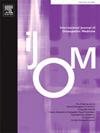Osteopathic manipulative treatment in cervical dystonia patients treated with IncobotulinumtoxinA
IF 1.5
4区 医学
Q2 MEDICINE, GENERAL & INTERNAL
引用次数: 0
Abstract
Background
Cervical dystonia (CD) is a neurological syndrome characterized by involuntary contractions in the cervical region, leading to abnormal head and shoulders postures, neck pain and tremors.
Objective
The objectives of this pilot study were to observe the impact of osteopathic manual Therapy (OMT) as an adjunct intervention on symptoms associated with CD in patients treated with injections of BotulinumtoxinA (BoNTA).
Method
This experimental research had a pretest-posttest design. The participants (n = 10) were randomly divided into 2 equal groups: experimental and control. Three questionnaires were used: TWSTRS (severity, disability and pain), CDIP-58 (quality of life) and CGI (evolution). Each patient had six visits over a BoNTA treatment cycle. Overall, three OMT or Sham treatments were administered.
Results
Overall, the percentage differences between groups were: 32.0 % better in the experimental group for the TWSTRS global score; 38.3 % for severity and 51.6 % for the pain subscore. The quality-of-life CDIP-58 score was 12.2 % better in the experimental group. As for the global evolution CGI score, the experimental group showed a 57.1 % of improvement compared to the control group. No adverse events associated with OMT were reported.
Conclusion
Results suggest that OMT could improve symptomology associated with CD, when administered as an adjunct therapy to BoNTA treatment; consequently, suggesting this care as an adjunct therapy. A larger-scale study would be required to validate findings.
肉毒杆菌毒素治疗颈肌张力障碍的整骨手法治疗
背景:颈肌张力障碍(CD)是一种以颈部不自主收缩为特征的神经系统综合征,可导致头部和肩部姿势异常、颈部疼痛和震颤。目的:本初步研究的目的是观察骨疗法(OMT)作为一种辅助干预对注射肉毒杆菌毒素(BoNTA)治疗的患者与CD相关症状的影响。方法采用前测后测设计。10名受试者随机分为实验组和对照组。采用三份调查问卷:TWSTRS(严重程度、残疾和疼痛)、CDIP-58(生活质量)和CGI(进化)。在BoNTA治疗周期中,每位患者有六次就诊。总的来说,进行了三次OMT或Sham治疗。结果两组间比较,实验组TWSTRS总分优于对照组32.0%;严重程度为38.3%,疼痛评分为51.6%。实验组生活质量CDIP-58评分提高12.2%。在全球进化CGI评分方面,实验组比对照组提高了57.1%。没有与OMT相关的不良事件的报道。结论:OMT作为BoNTA治疗的辅助治疗可改善CD相关症状;因此,建议将此护理作为辅助治疗。需要更大规模的研究来验证这些发现。
本文章由计算机程序翻译,如有差异,请以英文原文为准。
求助全文
约1分钟内获得全文
求助全文
来源期刊
CiteScore
2.20
自引率
36.80%
发文量
42
审稿时长
3 months
期刊介绍:
The International Journal of Osteopathic Medicine is a peer-reviewed journal that provides for the publication of high quality research articles and review papers that are as broad as the many disciplines that influence and underpin the principles and practice of osteopathic medicine. Particular emphasis is given to basic science research, clinical epidemiology and health social science in relation to osteopathy and neuromusculoskeletal medicine.
The Editorial Board encourages submission of articles based on both quantitative and qualitative research designs. The Editorial Board also aims to provide a forum for discourse and debate on any aspect of osteopathy and neuromusculoskeletal medicine with the aim of critically evaluating existing practices in regard to the diagnosis, treatment and management of patients with neuromusculoskeletal disorders and somatic dysfunction. All manuscripts submitted to the IJOM are subject to a blinded review process. The categories currently available for publication include reports of original research, review papers, commentaries and articles related to clinical practice, including case reports. Further details can be found in the IJOM Instructions for Authors. Manuscripts are accepted for publication with the understanding that no substantial part has been, or will be published elsewhere.

 求助内容:
求助内容: 应助结果提醒方式:
应助结果提醒方式:


